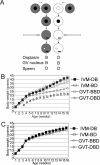Effects of ooplasm manipulation on DNA methylation and growth of progeny in mice
- PMID: 19073997
- PMCID: PMC2805397
- DOI: 10.1095/biolreprod.108.073593
Effects of ooplasm manipulation on DNA methylation and growth of progeny in mice
Abstract
New techniques to boost male and female fertility are being pioneered at a rapid pace in fertility clinics to increase the efficiency of assisted reproduction methods in couples in which natural conception has not been achieved. This study investigates the possible epigenetic effects of ooplasm manipulation methods on postnatal growth and development using a mouse genetic model, with particular emphasis on the possible effects of intergenotype manipulations. We performed interstrain and control intrastrain maternal pronuclear transfers, metaphase-II spindle transfers, and ooplasm transfer between C57BL/6 and DBA/2 mice, and found no major, long-term growth defects or epigenetic abnormalities, in either males or females, associated with intergenotype transfers. Ooplasm transfer itself was associated with reduced viability, and additional subtle effects of ooplasm strain of origin were observed. Both inter- and intrastrain ooplasm transfer were associated with subtle, transient effects on growth early in life. We also performed inter- and intrastrain germinal vesicle transfers (GVTs). Interstrain GVT females, but not males, had significantly lower body weights at birth and thereafter compared with the intrastrain GVT and non-GVT controls. No GVT-associated changes were observed in DNA methylation of the Mup1, Rasgrf1, H19, Snrpn, or Peg3 genes, nor any difference in expression of the imprinted Rasgrf1, Igf2r, or Mest genes. These results indicate that some ooplasm manipulation procedures may exert subtle effects on growth early in life, while intergenotype GVT can result in significant growth deficiencies after birth.
Figures




Similar articles
-
Effects of ooplasm transfer on paternal genome function in mice.Hum Reprod. 2009 Nov;24(11):2718-28. doi: 10.1093/humrep/dep286. Epub 2009 Aug 6. Hum Reprod. 2009. PMID: 19661122 Free PMC article.
-
Intergenerational impact of paternal lifetime exposures to both folic acid deficiency and supplementation on reproductive outcomes and imprinted gene methylation.Mol Hum Reprod. 2017 Jul 1;23(7):461-477. doi: 10.1093/molehr/gax029. Mol Hum Reprod. 2017. PMID: 28535307 Free PMC article.
-
The loss of imprinted DNA methylation in mouse blastocysts is inflicted to a similar extent by in vitro follicle culture and ovulation induction.Mol Hum Reprod. 2016 Jun;22(6):427-41. doi: 10.1093/molehr/gaw013. Epub 2016 Feb 7. Mol Hum Reprod. 2016. PMID: 26908643
-
Nuclear transfer in mouse oocytes and embryos.Methods Enzymol. 2010;476:171-84. doi: 10.1016/S0076-6879(10)76010-9. Methods Enzymol. 2010. PMID: 20691866 Review.
-
Ooplasmic donation in humans: the potential for epigenic modifications.Hum Reprod. 2002 Apr;17(4):850-2. doi: 10.1093/humrep/17.4.850. Hum Reprod. 2002. PMID: 11925371 Review.
Cited by
-
Ultrastructural Evaluation of the Human Oocyte at the Germinal Vesicle Stage during the Application of Assisted Reproductive Technologies.Cells. 2022 May 13;11(10):1636. doi: 10.3390/cells11101636. Cells. 2022. PMID: 35626673 Free PMC article. Review.
-
Autologous mitochondrial microinjection; a strategy to improve the oocyte quality and subsequent reproductive outcome during aging.Cell Biosci. 2019 Nov 29;9:95. doi: 10.1186/s13578-019-0360-5. eCollection 2019. Cell Biosci. 2019. PMID: 31798829 Free PMC article. Review.
-
Exploration of the Cytoplasmic Function of Abnormally Fertilized Embryos via Novel Pronuclear-Stage Cytoplasmic Transfer.Int J Mol Sci. 2021 Aug 16;22(16):8765. doi: 10.3390/ijms22168765. Int J Mol Sci. 2021. PMID: 34445470 Free PMC article.
-
Mitochondrial DNA disease: new options for prevention.Hum Mol Genet. 2011 Oct 15;20(R2):R168-74. doi: 10.1093/hmg/ddr373. Epub 2011 Aug 18. Hum Mol Genet. 2011. PMID: 21852248 Free PMC article. Review.
-
The role of mitochondria from mature oocyte to viable blastocyst.Obstet Gynecol Int. 2013;2013:183024. doi: 10.1155/2013/183024. Epub 2013 May 16. Obstet Gynecol Int. 2013. PMID: 23766762 Free PMC article.
References
-
- Hawes SM, Sapienza C, Latham KE.Ooplasmic donation in humans: the potential for epigenic modifications. Hum Reprod 2002; 17: 850–852. - PubMed
Publication types
MeSH terms
Substances
Grants and funding
LinkOut - more resources
Full Text Sources
Miscellaneous

